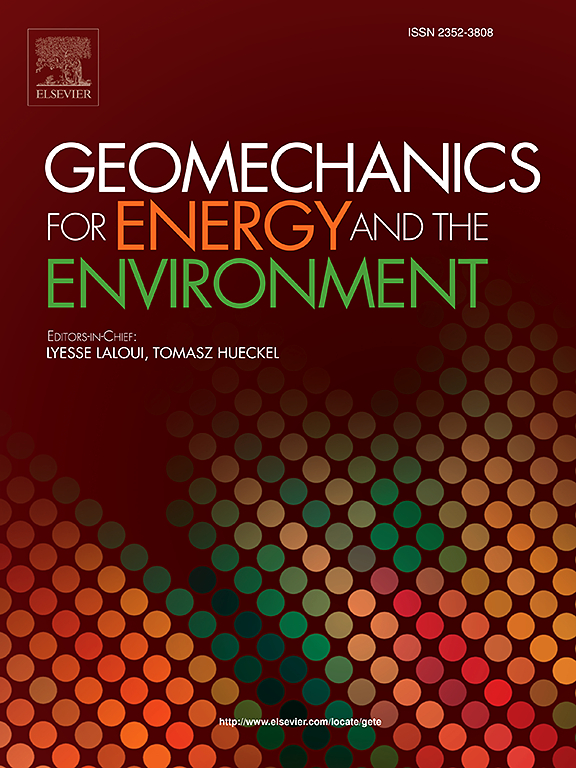威利斯顿盆地Deadwood组岩石物理与裂缝特征:对地热资源开发的启示
IF 3.7
2区 工程技术
Q3 ENERGY & FUELS
引用次数: 0
摘要
沉积盆地地热系统的表征面临着复杂储层非均质性的挑战,而传统的评价方法无法充分解决这一问题。本研究利用先进的岩石物理建模和统计裂缝分析技术,为北达科他州威利斯顿盆地的Deadwood组开发了一个综合的岩石物理结构框架。我们采用微分有效介质理论分析双峰孔隙结构(大孔隙10-100微米,微孔隙& 1微米),Kuster-Toksöz分析裂缝诱导的各向异性,宽高比为0.001-1.0,并采用经验约束参数的Gassmann流体替代。5毫米分辨率的地层微成像仪测井记录了450英尺内847条裂缝的统计特征,并通过蒙特卡罗模拟进行了不确定性量化。结果表明,该地区地热潜力巨大,有效梯度为34.6°C/km,显著超过典型沉积盆地值25-30°C/km,在3.0-3.1公里的经济可行深度达到160-162°C。裂缝网络遵循对数正态分布,体积强度为0.07-2.82裂缝/ft3,变异系数为79 %,需要随机建模方法。岩石物理建模成功识别出相关系数大于0.87的储层,确定B段和A段为最佳储层。经济分析表明,每千瓦时8.7美分的电力成本(置信区间:6.1-12.4)具有商业可行性,与可再生能源替代品具有竞争力。与典型的沉积勘探区相比,18.9-19.4 m /℃的优越深温比提供了25 - 45% %的成本优势。参数边界受岩心和测井数据约束(在蒸汽-盐水情景下,φ = 0.08 - 0.18; Ks = 37 - 43 GPa; K-f = 0.02 - 2.3 GPa), DEM中的干框架模量直接提供Gassman代入。这一综合框架推进了沉积地热评估,同时建立了可复制的全球应用协议,有助于实现可持续能源转型目标。本文章由计算机程序翻译,如有差异,请以英文原文为准。
Rock physics and fracture characterization of the Deadwood Formation, Williston Basin: Insights into geothermal resource development
Sedimentary basin geothermal systems face critical characterization challenges from complex reservoir heterogeneity that traditional assessment methods inadequately address. This study develops an integrated petrophysical-structural framework for the Deadwood Formation in North Dakota's Williston Basin using advanced rock physics modeling and statistical fracture analysis. We employed Differential Effective Medium theory for bimodal pore structures (macropores 10–100 micrometers, micropores <1 micrometer), Kuster-Toksöz analysis for fracture-induced anisotropy with aspect ratios 0.001–1.0, and Gassmann fluid substitution with empirically constrained parameters. Formation Micro-Imager logs at 5 millimeter resolution enabled statistical characterization of 847 fractures across 450 feet, with uncertainty quantification through Monte Carlo simulation. Results demonstrate exceptional geothermal potential with a validated gradient of 34.6°C/km, significantly exceeding typical sedimentary basin values of 25–30°C/km, achieving 160–162°C at economically viable depths of 3.0–3.1 kilometers. Fracture networks follow log-normal distributions with volumetric intensities of 0.07–2.82 fractures/ft3 and a coefficient of variation of 79 %, requiring stochastic modeling approaches. Rock physics modeling successfully discriminates reservoir zones with correlation coefficients exceeding 0.87, identifying Members B and A as optimal targets. Economic analysis demonstrates commercial viability with levelized electricity costs of 8.7 cents per kilowatt-hour (confidence interval: 6.1–12.4), competitive with renewable alternatives. The superior depth-to-temperature ratio of 18.9–19.4 m per degree Celsius provides 25–45 % cost advantages over typical sedimentary prospects. Parameter bounds were constrained by core and log data (φ = 0.08 – 0.18; Ks = 37 – 43 GPa; K-f = 0.02 – 2.3 GPa across steam-brine scenarios), with dry-frame moduli from DEM directly feeding Gassman substitution. This integrated framework advances sedimentary geothermal assessment while establishing replicable protocols for global application, contributing to sustainable energy transition goals.
求助全文
通过发布文献求助,成功后即可免费获取论文全文。
去求助
来源期刊

Geomechanics for Energy and the Environment
Earth and Planetary Sciences-Geotechnical Engineering and Engineering Geology
CiteScore
5.90
自引率
11.80%
发文量
87
期刊介绍:
The aim of the Journal is to publish research results of the highest quality and of lasting importance on the subject of geomechanics, with the focus on applications to geological energy production and storage, and the interaction of soils and rocks with the natural and engineered environment. Special attention is given to concepts and developments of new energy geotechnologies that comprise intrinsic mechanisms protecting the environment against a potential engineering induced damage, hence warranting sustainable usage of energy resources.
The scope of the journal is broad, including fundamental concepts in geomechanics and mechanics of porous media, the experiments and analysis of novel phenomena and applications. Of special interest are issues resulting from coupling of particular physics, chemistry and biology of external forcings, as well as of pore fluid/gas and minerals to the solid mechanics of the medium skeleton and pore fluid mechanics. The multi-scale and inter-scale interactions between the phenomena and the behavior representations are also of particular interest. Contributions to general theoretical approach to these issues, but of potential reference to geomechanics in its context of energy and the environment are also most welcome.
 求助内容:
求助内容: 应助结果提醒方式:
应助结果提醒方式:


